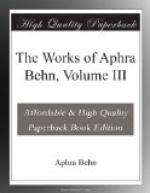p. 358 Enter Erminia veil’d. In Sir William Barclay’s The Lost Lady (folio 1639), a good, if intricate, tragi-comedy, which was received with applause after the Restoration [Pepys saw it 19 January, 1661, and again, rather more than a week later, on the 28th of the same month], and not forgotten by Buckingham when he penned The Rehearsal, Milesia (supposed dead), the wife of Lysicles, appears to her husband as a ghost —Act v, sc. I. It is very possible that Mrs. Behn hence took her hint for the phantom of the living Erminia. It is noticeable that generations after Tobin borrowed not a few incidents from The Lost Lady for The Curfew, produced at Drury Lane, 19 February, 1807, a posthumous play. In Lodowick Carlell’s The Fool Would be a Favourite; or, The Discreet Lover (12mo, 1657), we have Philantus confronting Lucinda as his own ghost—(Actus Quintus).
p. 358 Tiffany. A kind of thin silk gauze. cf. Philemon Holland’s Plinie, Bk. XI, ch. xxii: ’The invention of that fine silke, tiffanie, sarcenet, and cypres, which instead of apparell to cover and hide, shew women naked through them.’ All subsequent editions to 4to 1671, read ‘taffety’ in this passage.
THE EMPEROR OF THE MOON.
p. 390 Lord Marquess of Worcester. Charles, Marquis of Worcester (1661-1698), father of Henry Somerset, second Duke of Beaufort, was the second son [Henry, his elder brother, died young] of Henry Somerset, first Duke of Beaufort (1629-1700), by Mary, eldest daughter of Arthur, first Lord Capel. The first Duke of Beaufort, the staunchest of Tories, was high in favour with Charles I, Charles II, and James II. Charles, the son and heir, was killed through an accident to his coach in Wales, July, 1698, and the shock is said to have hastened the old Duke’s end.
p. 391 acted in France eighty odd times. The original scenes were produced by the Italian comedians at the Hotel de Bourgogne, 5 March, 1684. Their popularity did not wane for many a decade. In the fifth edition (1721) of Gherardi’s Theatre Italien there are far fuller excerpts from the farce than in the first edition (1695).
p. 392 who now cannot supply one. The Theatre Royal, Drury Lane. If Mrs. Behn’s complaint about the public is true, James II was, none the less, himself a good friend to the stage, and many excellent plays were produced during his reign. There is, however, considerable evidence that at this period of strife—religious and political, rebellion and revolt —things theatrical were very badly affected, and the play-house poorly attended.
p. 393 No Woman without Vizard. cf. Cibber in his Apology (1740), ch. viii: ’I remember the ladies were then observed to be decently afraid of venturing bare-faced to a new comedy, till they had been assured they might do it, without the risk of an insult to their modesty: or, if their curiosity were too strong for their patience, they took care, at least, to save appearances, and rarely came upon the first days of acting but in masks (then daily worn, and admitted in the pit, the side-boxes, and gallery) which custom, however, had so many ill consequences attending it, that it has been abolished these many years.’




